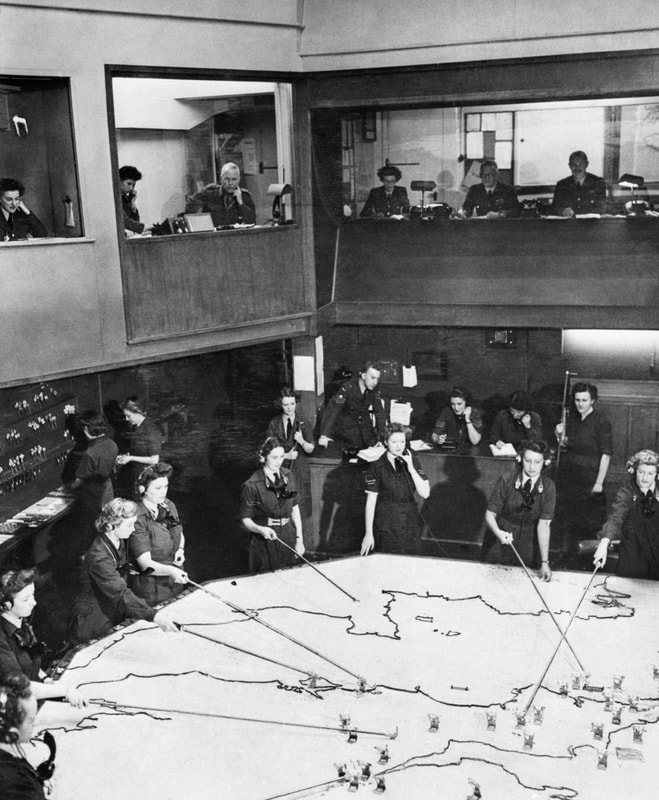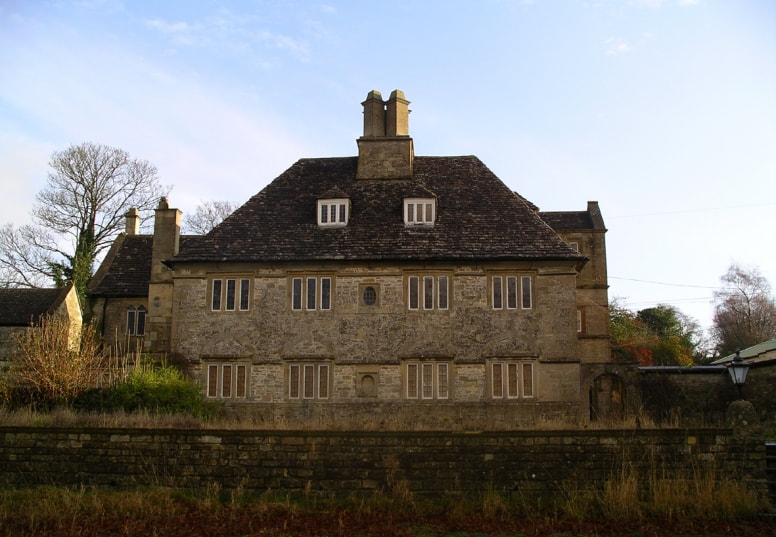|
Military Camps
Bill Cooper November 2017 There were several military camps scattered around the village during the Second World War, two of which were under the control of the Royal Pioneer Corps, plus one operated by the Royal Air Force. Royal Pioneer Corps Camps The Royal Pioneer Corps was formalised in 1939 to undertake various engineering and support tasks.[1] Its role was to take over logistics and the support duties that the Labour Corps had performed in the Great War. The badge of the Corps expressed its purpose by having an insignia with a rifle, a shovel and a pick under a crown and the motto Labor Omnia Vincit (Work Conquers All). By the end of the war, the Corps had one of the largest strengths in the Army at home and abroad, including thousands of civilian staff, The King's Most Loyal Enemy Aliens (often Jewish people opposed to the policies of their governments) and prisoners-of-war. |
One camp of the Royal Pioneer Corps in Box was at the junction of London Road and Bradford Road, just before the top of Rudloe. Their duties were to unload and re-load ammunition for the Central Ammunitions Depot, delivered underground by rail at the Corsham end of Box Tunnel.
The second camp was at Ashley, adjacent to the railway line and just beyond the Shockerwick footbridge. The duties here were again to unload ammunition from Corsham, then reload it on a funicular railway. The railway had two lines whereby one wagon was pulled up by cable whilst the other line lowered its wagon. The funicular ran from the wide siding just beyond the railway bridge on the road from Ashley, to a giant quarry at Monkton Farleigh. Presumably this was a supplementary storage facility.
The route of the funicular could be seen until the late 1960s.
The Central Ammunitions Depot was required to oversee the receipt of ammunition into the storage areas and the distribution of various types of ammunition to their required locations.
The second camp was at Ashley, adjacent to the railway line and just beyond the Shockerwick footbridge. The duties here were again to unload ammunition from Corsham, then reload it on a funicular railway. The railway had two lines whereby one wagon was pulled up by cable whilst the other line lowered its wagon. The funicular ran from the wide siding just beyond the railway bridge on the road from Ashley, to a giant quarry at Monkton Farleigh. Presumably this was a supplementary storage facility.
The route of the funicular could be seen until the late 1960s.
The Central Ammunitions Depot was required to oversee the receipt of ammunition into the storage areas and the distribution of various types of ammunition to their required locations.
Royal Air Force at Rudloe Manor
RAF Rudloe Manor was once called RAF Box but its name was changed partly to divert enemy notice away from Box village and the Central Ammunitions Depot. The headquarters was sited on the track leading to No-Notion on the boundary of Box and Hartham. But the main working areas were underground in the excavated quarries where the tracking and prediction of enemy air raids was monitored by the Group 10 unit responsible for protecting the south-west of England (see headline phototgraph).
There were various activities carried on in the establishment. The Operations Room, initially at the Manor House but later established in the quarries, co-ordinated the response of RAF planes. The Filter Room was the intelligence section.
The Communications Centre, which was responsible for transmission of information, was mainly staffed by Women's Auxiliary Air Force (WAAF) members.
RAF Rudloe Manor operated independently of the Royal Air Force bomb stores at Ridge Quarry and Eastlays, Gastard, which were depots under the Central Ammunitions Depot.[2] The storage areas there were considerably expanded after January 1942 when there was a collapse at the Llanberis Slate Quarry, North Wales, and the destruction of 75,000 high explosive bombs stored there.[3]
The area headquarters of the RAF remained at Rudloe Manor long after the end of hostilities.
HMS Royal Arthur
After the war, along the Bradford Road towards Wadswick, there was HMS Royal Arthur, a naval detachment. Its purpose was as an induction centre for rating new recruits who were assessed for appropriate duties, received uniforms and were assigned to new locations. The facility was mainly used after the war ended when it replaced a similar base operating at Butlins Holiday Camp, Skegness.
Later the site became a leadership training centre for the Royal Navy at the instigation of Lord Louis Mountbatten. In 1947 the Duke of Edinburgh, then known as Philip Mountbatten, instructed cadets at the Petty Officer training school at Westwells.
RAF Rudloe Manor was once called RAF Box but its name was changed partly to divert enemy notice away from Box village and the Central Ammunitions Depot. The headquarters was sited on the track leading to No-Notion on the boundary of Box and Hartham. But the main working areas were underground in the excavated quarries where the tracking and prediction of enemy air raids was monitored by the Group 10 unit responsible for protecting the south-west of England (see headline phototgraph).
There were various activities carried on in the establishment. The Operations Room, initially at the Manor House but later established in the quarries, co-ordinated the response of RAF planes. The Filter Room was the intelligence section.
The Communications Centre, which was responsible for transmission of information, was mainly staffed by Women's Auxiliary Air Force (WAAF) members.
RAF Rudloe Manor operated independently of the Royal Air Force bomb stores at Ridge Quarry and Eastlays, Gastard, which were depots under the Central Ammunitions Depot.[2] The storage areas there were considerably expanded after January 1942 when there was a collapse at the Llanberis Slate Quarry, North Wales, and the destruction of 75,000 high explosive bombs stored there.[3]
The area headquarters of the RAF remained at Rudloe Manor long after the end of hostilities.
HMS Royal Arthur
After the war, along the Bradford Road towards Wadswick, there was HMS Royal Arthur, a naval detachment. Its purpose was as an induction centre for rating new recruits who were assessed for appropriate duties, received uniforms and were assigned to new locations. The facility was mainly used after the war ended when it replaced a similar base operating at Butlins Holiday Camp, Skegness.
Later the site became a leadership training centre for the Royal Navy at the instigation of Lord Louis Mountbatten. In 1947 the Duke of Edinburgh, then known as Philip Mountbatten, instructed cadets at the Petty Officer training school at Westwells.
References
[1] http://royalpioneercorps.co.uk/rpc/history_main1.htm
[2] Nick McCamley, Subterranean Britain: Second World War Secret Bunkers, 2010, Folly Books, p.2-3
[3] Nick McCamley, Subterranean Britain: Second World War Secret Bunkers, p.173
[1] http://royalpioneercorps.co.uk/rpc/history_main1.htm
[2] Nick McCamley, Subterranean Britain: Second World War Secret Bunkers, 2010, Folly Books, p.2-3
[3] Nick McCamley, Subterranean Britain: Second World War Secret Bunkers, p.173

